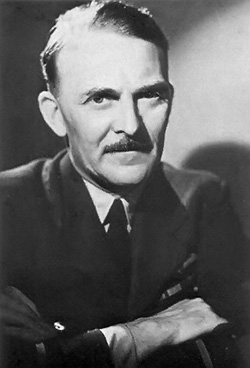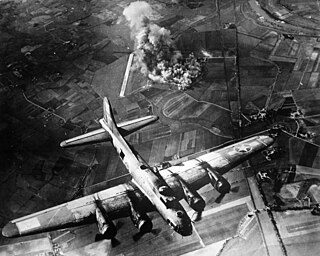
Strategic bombing is a military strategy used in total war with the goal of defeating the enemy by destroying its morale, its economic ability to produce and transport materiel to the theatres of military operations, or both. It is a systematically organized and executed attack from the air which can utilize strategic bombers, long- or medium-range missiles, or nuclear-armed fighter-bomber aircraft to attack targets deemed vital to the enemy's war-making capability. The term terror bombing is used to describe the strategic bombing of civilian targets without military value, in the hope of damaging an enemy's morale.

The Blitz was a German bombing campaign against the United Kingdom, in 1940 and 1941, during the Second World War. The term was first used by the British press and originated from the term Blitzkrieg, the German word meaning 'lightning war'.
The Battle of the Beams was a period early in the Second World War when bombers of the German Air Force (Luftwaffe) used a number of increasingly accurate systems of radio navigation for night bombing in the United Kingdom. British scientific intelligence at the Air Ministry fought back with a variety of their own increasingly effective means, involving jamming and deception signals. The period ended when the Wehrmacht moved their forces to the East in May 1941, in preparation for the attack on the Soviet Union.
Bomber Command is an organisational military unit, generally subordinate to the air force of a country. The best known were in Britain and the United States. A Bomber Command is generally used for strategic bombing, and is composed of bombers.

Heavy bombers are bomber aircraft capable of delivering the largest payload of air-to-ground weaponry and longest range of their era. Archetypal heavy bombers have therefore usually been among the largest and most powerful military aircraft at any point in time. In the second half of the 20th century, heavy bombers were largely superseded by strategic bombers, which were often smaller in size, but had much longer ranges and were capable of delivering nuclear bombs.
This is a list of aviation-related events from 1944:
The Pathfinders were target-marking squadrons in RAF Bomber Command during World War II. They located and marked targets with flares, which a main bomber force could aim at, increasing the accuracy of their bombing. The Pathfinders were normally the first to receive new blind-bombing aids like Gee, Oboe and the H2S radar.

Berlin, the capital of Nazi Germany, was subject to 363 air raids during the Second World War. It was bombed by the RAF Bomber Command between 1940 and 1945, the United States Army Air Forces' Eighth Air Force between 1943 and 1945, and the French Air Force in 1940 and between 1944 and 1945 as part of the Allied campaign of strategic bombing of Germany. It was also attacked by aircraft of the Red Air Force in 1941 and particularly in 1945, as Soviet forces closed on the city. British bombers dropped 45,517 tons of bombs, while American aircraft dropped 22,090.3 tons. As the bombings continued, more and more people fled the city. By May 1945, 1.7 million people had fled.

Oboe was a British bomb aiming system developed to allow their aircraft to bomb targets accurately in any type of weather, day or night. Oboe coupled radar tracking with radio transponder technology. The guidance system used two well separated radar stations to track the aircraft. Two circles were created before the mission, one around each station, such that they intersected at the bomb drop point. The operators used the radars, aided by transponders on the aircraft, to guide the bomber along one of the two circles and drop the bombs when they reached the intersection.
Gee-H, sometimes written G-H or GEE-H, was a radio navigation system developed by Britain during World War II to aid RAF Bomber Command. The name refers to the system's use of the earlier Gee equipment, as well as its use of the "H principle" or "twin-range principle" of location determination. Its official name was AMES Type 100.

The Pointblank directive authorised the initiation of Operation Pointblank, the code name for the part of the Allied Combined Bomber Offensive intended to cripple or destroy the German aircraft fighter strength, thus drawing it away from frontline operations and ensuring it would not be an obstacle to the invasion of Northwest Europe. The Pointblank directive of 14 June 1943 ordered RAF Bomber Command and the U.S. Eighth Air Force to bomb specific targets such as aircraft factories, and the order was confirmed when the Allies met at the Quebec Conference, 1943.
Big Week or Operation Argument was a sequence of raids by the United States Army Air Forces and RAF Bomber Command from 20 to 25 February 1944, as part of the European strategic bombing campaign against Nazi Germany. The planners intended to attack the German aircraft industry to lure the Luftwaffe into a decisive battle where the Luftwaffe could be damaged so badly that the Allies would achieve air superiority which would ensure success of the invasion of continental Europe.

The Schweinfurt–Regensburg mission was a strategic bombing mission during World War II carried out by Boeing B-17 Flying Fortress heavy bombers of the U.S. Army Air Forces on August 17, 1943. The mission was an ambitious plan to cripple the German aircraft industry; it was also known as the "double-strike mission" because it entailed two large forces of bombers attacking separate targets in order to disperse fighter reaction by the Luftwaffe. It was also the first American shuttle mission, in which all or part of a mission landed at a different field and later bombed another target before returning to its base.

Air Vice Marshal Edward Barker Addison, was a senior Royal Air Force (RAF) officer who served as Air Officer Commanding No. 100 Group from 1943 to 1945 during the Second World War. The group jammed Axis radar and communications systems from the air and Addison was its only commander.

The Combined Bomber Offensive (CBO) was an Allied offensive of strategic bombing during World War II in Europe. The primary portion of the CBO was directed against Luftwaffe targets which was the highest priority from June 1943 to 1 April 1944. The subsequent highest priority campaigns were against V-weapon installations and petroleum, oil, and lubrication (POL) plants. Additional CBO targets included railyards and other transportation targets, particularly prior to the invasion of Normandy and, along with army equipment, in the final stages of the war in Europe.

The Defence of the Reich is the name given to the strategic defensive aerial campaign fought by the Luftwaffe of Nazi Germany over German-occupied Europe and Germany during World War II. Its aim was to prevent the destruction of German civilians, military and civil industries by the Western Allies. The day and night air battles over Germany during the war involved thousands of aircraft, units and aerial engagements to counter the Allied strategic bombing campaign. The campaign was one of the longest in the history of aerial warfare and with the Battle of the Atlantic and the Allied Blockade of Germany was the longest of the war. The Luftwaffe fighter force defended the airspace of German-occupied territory against attack, first by RAF Bomber Command and then against the United States Army Air Forces (USAAF) in the Combined Bomber Offensive.

The Battle of the Heligoland Bight was the first "named" air battle of the Second World War, which began the longest air campaign of the war on 3 September 1939, the Defence of the Reich. After the declaration of war, RAF Bomber Command began operations against Nazi Germany but limited their attacks to those targets that were purely military and had little risk of civilian casualties. This largely limited their efforts to attacks on the Kriegsmarine warships in German ports to prevent their use in the Battle of the Atlantic.

The Bombing of Yawata on the night of 15/16 June 1944 marked the beginning of the United States Army Air Forces (USAAF) strategic bombing campaign against the Japanese home islands during World War II and was the first such raid to employ strategic bombers. The raid was undertaken by 75 Boeing B-29 Superfortress heavy bombers staging from bases in China. Only 47 of these aircraft dropped bombs near the raid's primary target, the Imperial Iron and Steel Works at Yawata in northern Kyūshū, and little damage was caused. Five B-29s were lost in accidents during the operation and two were destroyed by Japanese aircraft.

A night bomber is a bomber aircraft intended specifically for carrying out bombing missions at night. The term is now mostly of historical significance. Night bombing began in World War I and was widespread during World War II. A number of modern aircraft types are designed primarily for nighttime bombing, but air forces no longer refer to them as night bombers. More common terms today include interdictor and strike fighter, and such aircraft tend to have all-weather, day-or-night capabilities.













